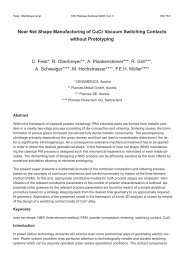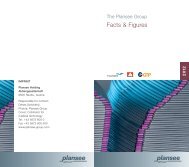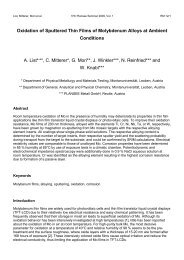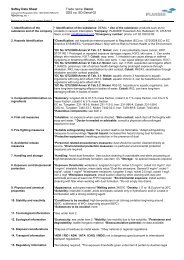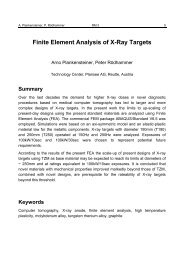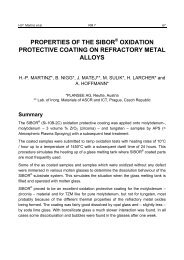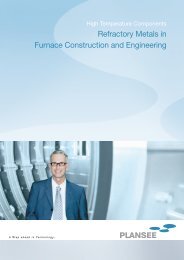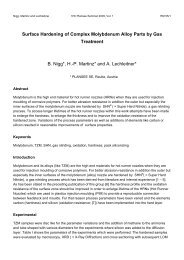Investigation of Solid Solution Hardening in Molybdenum Alloys
Investigation of Solid Solution Hardening in Molybdenum Alloys
Investigation of Solid Solution Hardening in Molybdenum Alloys
Create successful ePaper yourself
Turn your PDF publications into a flip-book with our unique Google optimized e-Paper software.
RM 18/12 17th Plansee Sem<strong>in</strong>ar 2009, Vol. 1 Wesemann, H<strong>of</strong>fmann et al.<br />
Although Suzuki considers thermal activation the results were even worse. The correlation between<br />
calculated and experimentally determ<strong>in</strong>ed values show a low degree <strong>of</strong> correlation with R 2 =0.16. The<br />
bad results are attributed to the def<strong>in</strong>ition <strong>of</strong> EW and δ” (table I). These two parameters were def<strong>in</strong>ed and<br />
pro<strong>of</strong>ed for iron but not for molybdenum.<br />
dHV10/dc (measured)<br />
3000<br />
2000<br />
1000<br />
Suzuki R 2 = 0.86<br />
Fleischer R 2 = 0.91<br />
Labusch R 2 = 0.98<br />
0<br />
0 1000 2000<br />
dτ crit /dc (calculated)<br />
Fig. 12: Comparison <strong>of</strong> the calculated solid solution harden<strong>in</strong>g dτcrit/dc by the different theories and the actually measured solid<br />
solution harden<strong>in</strong>g dHV10/dc at room temperature<br />
Conclusions<br />
The sample characterisation has shown that the manufactur<strong>in</strong>g <strong>of</strong> homogeneous molybdenum solid<br />
solution alloys by powder metallurgy is quite difficult. For a complete homogenization long last<strong>in</strong>g high<br />
temperature solution anneal<strong>in</strong>g is required which resulted <strong>in</strong> significant gra<strong>in</strong> growth. Large gra<strong>in</strong><br />
complicated the determ<strong>in</strong>ation <strong>of</strong> the lattice parameters and modulus <strong>of</strong> rigidity.<br />
Except for the molybdenum-tantalum alloys all other alloys undergo a cont<strong>in</strong>uous decrease <strong>in</strong> gra<strong>in</strong> size<br />
with <strong>in</strong>creas<strong>in</strong>g alloy content. At room temperature the molybdenum-chromium alloys and molybdenum-<br />
rhenium alloys showed solid solution s<strong>of</strong>ten<strong>in</strong>g at concentrations up to 1% and 3% respectively. At<br />
higher concentrations solid solution harden<strong>in</strong>g was observed. Chromium as alloy<strong>in</strong>g element exhibited<br />
the highest harden<strong>in</strong>g rate at room temperature followed by titanium, tantalum and rhenium. Tungsten<br />
shows a weak solid solution harden<strong>in</strong>g. At 500°C molybdenum-chromium showed the highest solid<br />
solution harden<strong>in</strong>g. Moderate harden<strong>in</strong>g was observed for molybdenum-tantalum and molybdenumrhenium<br />
while molybdenum-tungsten and molybdenum-titanium showed only very low solid solution<br />
harden<strong>in</strong>g at this temperature. A strong gra<strong>in</strong> size harden<strong>in</strong>g effect was observed for pure molybdenum<br />
at 500°C for gra<strong>in</strong> sizes below 50µm. The gra<strong>in</strong> size effect was negligible for the <strong>in</strong>vestigated alloys<br />
which showed gra<strong>in</strong> sizes above 80µm.<br />
To describe the solid solution harden<strong>in</strong>g <strong>in</strong> molybdenum the theory <strong>of</strong> Labsuch is most suitable at room<br />
temperature. Although the theory <strong>of</strong> Labusch was developed for solid solution harden<strong>in</strong>g at 0K, it is still<br />
<strong>in</strong> good agreement at 500°C. Fleischer´s theory showed good agreement at room temperature, too, but





